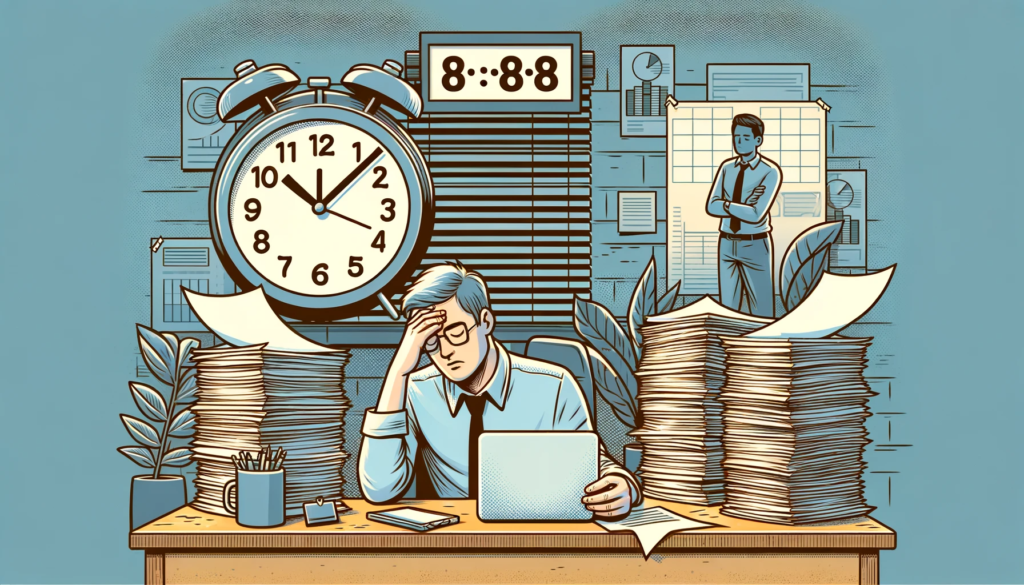No products in the cart.
5-Hour Workday: The Hourglass Reshaped
Discover the transformative potential of the 5-hour workday - a bold reimagining of traditional work practices that promises enhanced productivity, employee well-being, and a balanced approach to modern working life.
For over a century, the 8-hour workday has reigned supreme, a relic of the industrial revolution etched into the fabric of our global work ethic. But in the dynamic landscape of the 21st century, characterized by digital revolution and remote work possibilities, this rigid timekeeper faces a formidable challenger: the 5-hour workday. Rising not from mere workaholic tendencies, but from a deep understanding of human productivity and well-being, this movement proposes a radical reshaping of our relationship with work, with far-reaching implications for individuals, organizations, and the very nature of a thriving society.
Beyond Counting Hours: Redefining Productivity in a Time-Starved Age
The foundation of the 5-hour workday lies not in squeezing more work into less time, but in challenging the very notion of equating hours spent with output achieved. Research in cognitive science and neuroscience reveals the diminishing returns of extended cognitive focus. After periods of prolonged work, our brains experience fatigue, diminishing concentration, and ultimately, a decline in productivity. As psychologist Daniel Kahneman explains in his landmark book “Thinking, Fast and Slow,” our “System 2,” responsible for focused attention, operates efficiently for only limited periods, while our “System 1,” prone to biases and shortcuts, takes over in sustained work phases, leading to errors and inefficiencies. The 5-hour workday champions this understanding, proposing a condensed schedule that maximizes focused work periods, allowing for optimal cognitive output while prioritizing recovery and well-being.
Global Success Stories: From Tokyo to Tel Aviv
This shift is not merely theoretical; real-world experiments paint a compelling picture of the 5-hour workday’s potential. Microsoft Japan’s trial implementation resulted in a remarkable 40% increase in productivity, showcasing the power of focused work within a shorter timeframe. In New Zealand, companies like Perpetual Guardian reported a 20% decrease in stress and a 27% increase in employee satisfaction after adopting a 4-day workweek, highlighting the global well-being benefits of this model. Even in developing countries, the IT consultancy firm HackerEarth in India reported a 30% increase in employee productivity and a 40% increase in employee referrals after implementing a 4-day week with no pay cut. These diverse examples challenge the notion that the 5-hour workday is limited to specific cultures or industries, demonstrating its adaptability and effectiveness across geographical and business landscapes.

Navigating the Obstacles: A Roadmap for Implementing the 5-Hour Revolution
While the allure of increased productivity and employee well-being is undeniable, successfully implementing the 5-hour workday requires navigating specific challenges:
- Workload Management: Condensing a full day’s work into five hours necessitates ruthless prioritization. Tools like the Eisenhower Matrix and Stephen Covey’s “Time Management Quadrant” can guide this process, allowing employees to focus on urgent and important tasks while streamlining or delegating less critical activities.
- Communication Efficiency: With less time in the office, clear and concise communication becomes crucial. Utilizing project management tools like Asana or Trello can keep everyone in sync across time zones and cultures, while asynchronous communication techniques like email or Slack can facilitate collaboration without constant disruption.
- Cultural Shifts: Embracing the 5-hour workday often requires challenging deep-seated cultural norms that glorify overwork and equate long hours with dedication. Open communication about workload and well-being, highlighting the success stories of early adopters from diverse cultures, can be crucial in overcoming these ingrained attitudes.
- Employee Adaptation: Adjusting to a more intense, focused work period can be a significant shift for employees accustomed to the traditional workday rhythm. Companies can offer training on time management and focus techniques, encourage experimentation with individual work styles, and provide access to wellness resources to support the transition.
Beyond Business: Redefining Success in a Holistic World
The implications of the 5-hour workday extend far beyond the realm of productivity and efficiency. This shift fosters a holistic approach to work, prioritizing not just professional success but also individual well-being and contribution to a thriving society.
- Work-Life Balance: With more personal time, employees can dedicate to family, hobbies, and personal growth, leading to a more fulfilling and balanced life. This contributes to a healthier and more engaged workforce, benefiting both individuals and organizations.
- Reduced Burnout: Shorter workdays can significantly reduce stress and prevent burnout, creating a more sustainable and enjoyable work environment. This can lead to lower absenteeism, higher employee retention, and ultimately, a more positive and productive workforce.
- Community Engagement: Freed from the shackles of a 50-hour workweek, individuals can contribute more actively to their communities, volunteering their time and skills for social causes. This fosters a stronger sense of connection and civic engagement, contributing to a more vibrant and cohesive society.
Reshaping the Global Landscape: The Ripple Effects of the 5-Hour Workday
The potential of the 5-hour workday extends beyond individual communities, sparking a ripple effect that can reshape the global landscape in several ways:
1. Bridging the Inequality Gap: By providing more personal time, particularly for low-wage earners and marginalized groups, the 5-hour model empowers individuals to pursue education, skill development, and entrepreneurial ventures. This can ultimately contribute to closing the income gap and promoting social mobility on a global scale.
2. Rethinking Gender Roles and Family Dynamics: Shorter work hours can challenge traditional gender divisions of labor, allowing both men and women to share childcare and household responsibilities more equitably. This can empower women to participate more fully in the workforce and contribute to a more balanced and inclusive society.
3. Environmental Benefits: A condensed workweek could lead to a reduction in overall commuting and energy consumption, contributing to a greener and more sustainable planet. This is particularly relevant in light of the urgent need to combat climate change, and shorter work hours can encourage individuals to adopt more environmentally friendly lifestyles.
4. Boosting Local Economies: With more free time, individuals are likely to spend more in their local communities, supporting small businesses and cultural activities. This can revitalize local economies, particularly in rural areas or struggling towns, and contribute to a more diverse and prosperous global economy.
5. Global Collaboration and Innovation: As the 5-hour workday gains traction across cultures, it can facilitate more seamless collaboration and knowledge sharing across borders. This can stimulate global innovation in various fields, from healthcare and technology to renewable energy and social development.

The Road Ahead: Embracing a Future of Flexibility and Well-being
The 5-hour workday is not a singular solution, but rather a catalyst for a broader conversation about redefining our relationship with work in the 21st century. It challenges the outdated notion of equating long hours with productivity and prioritizes human well-being, individual growth, and meaningful contribution to society.
Embracing this shift requires a commitment from individuals, organizations, and governments alike. Individuals must be open to adapting their work styles and embracing personal well-being. Organizations must demonstrate leadership in implementing flexible work models and prioritizing employee health and satisfaction. Governments need to be responsive to the changing landscape by adapting labor laws and social safety nets to support a shorter workweek model.
The journey towards a 5-hour workday will not be without its challenges and complexities. Yet, the potential rewards are immense: a more productive, engaged workforce, a healthier and happier population, and a more vibrant and equitable global society. By embracing flexibility, fostering collaboration, and prioritizing human well-being, we can navigate the obstacles and unlock the transformative power of this revolutionary work model.
The 5-hour workday is not merely a workplace trend, but a cultural shift waiting to unfold. It has the potential to reshape our relationship with work, redefine notions of success, and foster a more balanced and fulfilling future for individuals and societies across the globe. As we enter a new era of technological advancements and societal change, the time is ripe to embrace this paradigm shift and embark on a journey towards a future where work and well-being thrive in harmony.
Author
-

Career Ahead, the flagship handle of Career Ahead Magazine, is dedicated to molding the next generation of professionals and entrepreneurs. Our mission is to educate and inspire today's ambitious minds to become the icons of tomorrow. As the ultimate tool and resource, we cater to young students, budding entrepreneurs, and innovative startups, providing them with the knowledge and inspiration needed to navigate their paths to success. Through in-depth articles, insightful analysis, and inspiring stories, Career Ahead empowers its readers to forge their futures in the ever-evolving world of work and enterprise.












